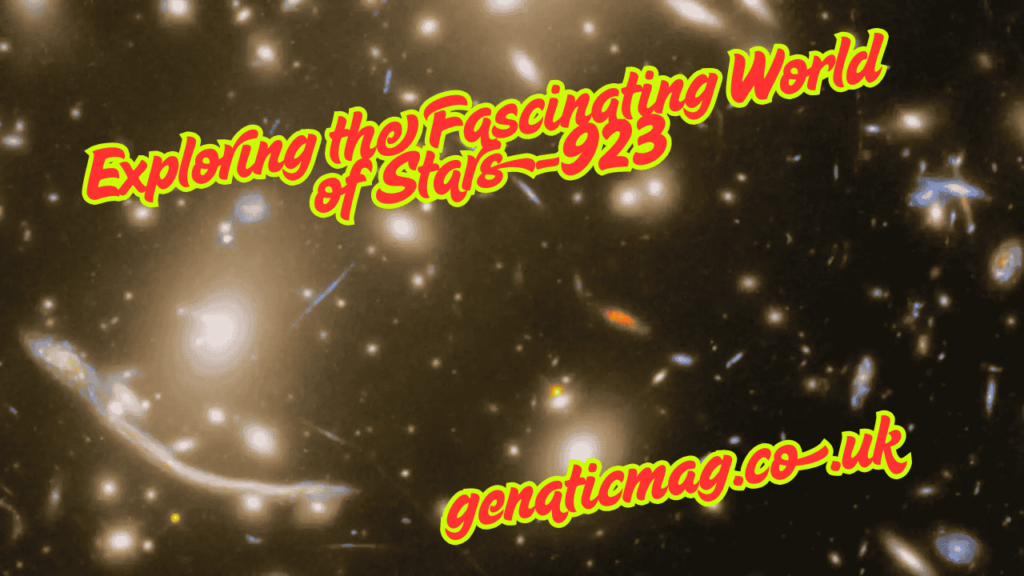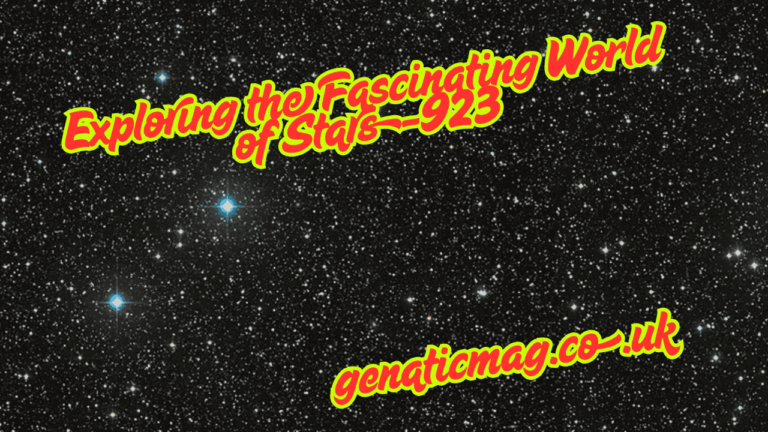Introduction: Exploring the Fascinating World of Stars-923, ??
The cosmos is a wide canvas studded with numerous marvels, and among its most compelling displays is the mysterious “Stars-923.” In this article, we begin on an intriguing trip, Exploring the Fascinating World of Stars-923, ??, to find the secrets, meaning, and beauty of this heavenly masterpiece. Whether you are a seasoned astronomer or a curious enthusiast, this investigation delivers a rich tapestry of discovery that uncovers the mysteries underlying one of the universe’s most captivating occurrences.
What is Stars-923? Unlocking the Basics

At the heart of Exploring the Fascinating World of Stars-923, ?? lies understanding what Stars-923 represents. Stars-923 is not just a single star, but rather a conceptual gateway into a broader system or category of celestial bodies, possibly symbolic of newer discoveries or imagined constellations. While traditional astronomy catalogs stars based on names and numbers, Stars-923 stands out as an entity shrouded in mystery, representing the unknown expanses still to be mapped and understood.
This mysterious label invites questions: Is Stars-923 a single star, a system, or an evolving phenomenon? Part of the fascination is precisely this uncertainty, making it a symbol of the unending quest for knowledge and the boundless wonder of the cosmos.
The Science Behind Stars-923: Cosmic Properties

When Exploring the Fascinating World of Stars-923, ??, it is vital to look into the scientific possibilities. If Stars-923 were a genuine phenomenon, scientists would analyze its mass, brightness, temperature, and spectrum classification. Stars often fall into many categories: dwarf stars, giants, supergiants, and neutron stars, each having distinct features.
Imagine Stars-923 as a vibrant, massive star teetering on the edge of its lifecycle, emitting powerful radiation and magnificent cosmic winds. It could be a cradle for new planets or a collapsing titan birthing a black hole. Exploring its cosmic properties allows us to speculate on its age, chemical composition, and potential influence on neighboring celestial bodies, adding a layer of intrigue to our journey.
Stars-923 and the Power of Imagination

Beyond scientific study, Exploring the Fascinating World of Stars-923, ?? plays into the power of imagination. Stars-923 might indicate a connection between established science and the imaginative creativity of space travel. Science fiction typically depicts stars as beacons for interplanetary travel, homes for extraterrestrial civilizations, or nodes in a vast cosmic network.
Imagining Stars-923 as the center of an interstellar hub or the last flickering light of a dying galaxy invites endless creative interpretations. It reminds us that astronomy is not just about facts and figures but also about inspiring stories, artistic visions, and a profound connection to the unknown.
The Importance of Stars-923 in Cultural Narratives
As we continue Exploring the intriguing World of Stars-923, ??, it’s intriguing to explore how societies throughout history have attributed meaningful meanings to stars. If Stars-923 were part of ancient tradition, it may be tied to tales of heavenly gods, omens, or navigational directions. Cultures have always turned to the heavens for inspiration, direction, and knowledge of their position in the cosmos.
Perhaps Stars-923 could represent a “wishing star” in future mythology, a symbol of hope, destiny, or cosmic rebirth. The human need to attach meaning to the stars is timeless, and Stars-923 fits seamlessly into this tradition, offering a new symbol for modern stargazers to cherish.
The Role of Modern Technology in Understanding Stars-923
Exploring the Fascinating World of Stars-923, ?? would not be complete without appreciating the contribution of contemporary technologies. Telescopes like the James Webb Space Telescope and space observatories are altering our perspective of the universe. If Stars-923 exists, it would likely be examined by infrared imaging, radio wave analysis, and spectroscopy.
Technology allows us to peer into the deepest parts of space, breaking through light-years of distance and cosmic dust. Hypothetically, advanced AI-driven analysis could one day uncover anomalies around Stars-923, revealing it to be an extraordinary celestial laboratory where new physics is born. The future of astronomy holds the promise of deeper, richer understanding — and Stars-923 could be at the center of that future exploration.
How Stars-923 Inspires Future Explorations
In Exploring the Fascinating World of Stars-923, ??, one cannot overlook the inspiration it provides for future missions and discoveries. Whether real or conceptual, Stars-923 challenges us to dream bigger, to ask more questions, and to venture further into the unknown.
It is a call to the next generation of scientists, engineers, and explorers to push the boundaries of what we know. Imagining expeditions to Stars-923 fosters innovation, from faster-than-light travel theories to sustainable space colonization projects. It embodies the spirit of adventure that defines humanity’s relationship with the stars.
Conclusion: Continuing the Journey Through Stars-923 and Beyond
As we conclude Exploring the Fascinating World of Stars-923, ??, we realize that the journey is far from over. Stars-923, whether a real celestial object or a symbolic construct, captures the essence of cosmic wonder. It represents our eternal desire to explore, understand, and find our place in the universe.
The story of Stars-923 is not just about distant light in the night sky — it is about us: our curiosity, our creativity, and our unyielding spirit. As long as there are stars above, and mysteries to solve, the adventure will continue, drawing us deeper into the awe-inspiring universe we call home
Also Read : Exploring the Fascinating World of Stars-923
